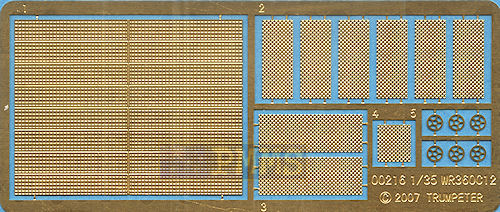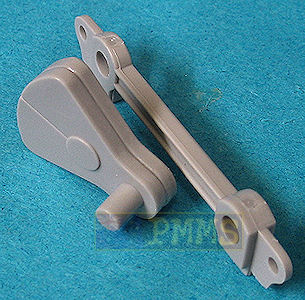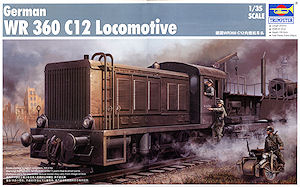Trumpeter continue their locomotive/rolling stock series of kits with this release of the German WR 360 C12 Locomotive of which only 10 were produced and were never used outside the borders of Germany being used mostly on shunting duties in rail yards and similar mundane tasks during their lifetimes which for some extended into the 1960’s.
The V36.0/WR 360 C12 was a diesel powered locomotive of modest size being only around 9 meters in length and was superseded by the slightly larger and more powerful V36.2-4/WR C14 which was built in larger numbers and used extensively during and after WWII with some still operating as late as 1974.
This has 247 parts in the usual Trumpeter light grey plastic along with 12 clear parts, 16 etched parts and the instruction booklet.
Standard of moulding is quite good overall with very little flash but there are some substantial pin marks about the place especially on the insides of the cabin walls and some quite prominent mould seams to be removed from the parts but the detail included on the parts is mostly crisp and well defined.
The main issue with the kit is the detail that isn’t included as it is really quite basic in parts most notably on the running gear and inside the cabin, but more on this below.
The only plans available are the 1:72 plans in the Wings & Wheels Publications WR 360 C14 in detail book and when enlarged to 1:35 show a number of small differences between 1-2mm with some smaller and some larger than the figures indicate which could be due to the enlargement process.
As I have said previously putting you house on a single set of plans is not a good idea and additional info would be required before a final verdict on the overall dimensions can be made, but as the discrepancies are not great there is nothing that makes the kit look out of shape or the like.

Clear parts

The two long side chassis frames have bolt head and other detail included on the outer side and separate large mounting brackets with bolt and flange details included added to the insides to attach the axles, water tank and bulkheads resulting in a quite good representation of the C12 lower chassis assembly.
Added to this is the running gear made up of the three wheels per side with connecting arms and the large idler shaft counterweight between the second and third axles but the detail on these parts is very basic indeed and lacks any of the actual details seen on the real parts.
The wheels have separate crescent shaped counterweights added to the outside (parts C8) but these have sharp edges while the real parts have rounded edges so you have to round the edges of the parts before fitting, not a big task. The shape of the arm attachment spoke lacks any of the contours seen on the actual arm but there is little you can do other than a major rebuild of the spoke if this is of concern. There is also no embossed stencil data on the wheels but this is hard to see in scale so again may not be a big issue.
The large idler shaft counterweight is in two halves and when joined together leaves a prominent join seam that needs to be eliminated with filling and sanding and there are smaller details missing from counterweight if you wanted to add these?

On the connecting arms there is a prominent mould line that will need to be removed but the attachment bolt bosses lack any detail at all as well as other bolt and attachment fittings missing making for a very plain looking assembly and some work will be needed to add the missing detail.
For some strange reason the locating tabs for the counterweight only allow this to be fitted in two positions, either vertical or horizontal with the wheels aligned accordingly but modifying the attachment pin and drilling out the locating hole on the counterweight will allow you to position the wheels and counterweight at any position for a bit of variety.
Also added to the chassis are the large underside brake drawbars and the two part brakes aligned with each wheel as well as the curved water pipes and the hydraulic oil cooler but the sand dispensing system and associated piping is completely missing as are the support fillets under the upper walkway.
This all leaves plenty of scope for adding considerable detail to the running gear for those wanting to really detail up the model and the Wings & Wheels WR 360 C14 book is an indispensable reference for those game as the detail on the C14 running gear is essentially identical to the C12 only with the wheels spaced differently.
The chassis end plates have additional parts for the central coupling hook made up of five parts each for a good representation as well as the oil hoses and footsteps. The large round bumpers correctly have the convex bumper plate on the left and the flat plate on the right so take care to attach these on the correct side? Also included on the bumpers are the small footsteps as they should.
The assembled chassis/running gear is then attached to the upper chassis bed that includes the cabin floor and side walkways and added to this are additional smaller tanks and storage boxes as well as the front and rear steps. These are made up of plastic side frames and etched steps with tread plate and make into quite nice looking step assemblies.
The large engine compartment is a single large moulding that includes the front radiator bars cleanly moulded with separate side louver panels and top access hatches.
This is thankfully moulded perfectly square without any warping and adding the side louver panels straightforward, just watch the orientation of the louvers as it is easy for these to be fitted upside down if not careful?
At the front is the large radiator assembly with an etched front grill panel and this sits behind the front radiator bars when the engine compartment is attached to the lower chassis floor which it does very precisely due to the raised locating panel in the centre of the floor panel.
Added to the engine compartment are the upper hand rails as well as smaller hand holds on the louver panels and these are moulded quite thin requiring care when removing from the sprues and during cleanup of the fine mould seams.
Added to the front of the walkway are the two headlights made up of two parts plus the clear lens but again the detail on these is quite basic with excellent images of the lights in the Wings & Wheels book for those wanting to add the additional details.
This is made up of the four separate walls and two roof panels that have details on both sides but also includes quite large pin marks in the inside of all panels and due to the large windows these can be easily seen if left unattended.
Interior detail includes the main control panel with additional hand wheel and levers but the instrument dials are just plain discs without any instrument detail (another subject for Archer’s dial sets?).
On the front bulkhead are the two large main starting valves made up of two plastic parts and three small etched hand wheels each with connecting piping but the four gauges and associated piping are missing from the bulkhead and will have to be added.
The only other detail is the driver’s seat with mounting post but there is quite a lot of additional piping and wiring that can be added to the walls to add more detail to the interior. The windows are provided as clear parts and the two rear lights are similar to the front lights with clear lenses but again lacking detail.
Assembly of the cabin is quite straightforward with good fit of the main panels but there are a few join seams to be filled with some of the panel joins and added to the cabin are additional fine hand rails and the three small sirens on the front panel.
The assembled cabin is again a good fit to the back of the engine compartment and the lower chassis/floor with the large ladder added at the front left of the compartment. This is made up of two plastic halves with etched top step and as the parts are quite finely moulded care will be needed during cleanup and assembly.
Included in the kit is a section of rail track with sleepers and track bed the same as included in the previous Karl and Leopold kits. These assembly easily and gives you a good base to sit the assembled loco on.
These are the usual exploded view type drawings with the sequences being very clear and easy to follow and I didn’t come across any bloopers in the sections of the kit assembled during this review.
|
This is a fairly basic kit of the WR 360 C12 with not a lot of parts which makes for fairly straightforward assemble but much of the detail is simplified or lacking especially on the running gear and cabin interior which provides scope for those wanting to detail up the model to really go to town.
The choice of the C12 with just 10 built and not used outside of Germany instead of the more common C14 really does limit the diorama possibilities if you want accuracy with only the later C14s used for the more exotic duties such as working with Leopolds and other equipment.
Recommended
Click on thumbnails for larger view








Detail images

Close new window to return to review
| WR 360 C14
in detail Special Museum Line No.R 050 Wings & Wheels Publications. ISBN: 978-80-86416-77-9  |
Trumpeter is distributed in Australia by J.B.Wholesalers who provided the review kit.



